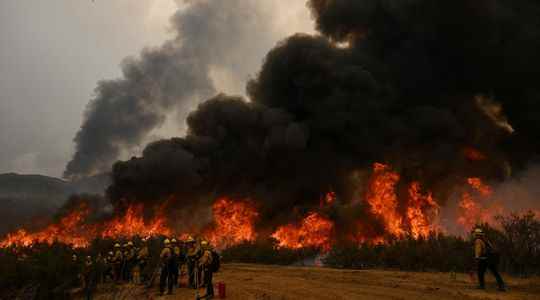In the West of the United States, the fate persists. Already fighting the Fairview fire on the outskirts of Los Angeles, firefighters were preparing, Friday, September 9, to face a new danger: floods and mudslides that could trigger a tropical storm coming from Mexico. Downgraded from the hurricane category when it made landfall in Mexico on Thursday, Storm Kay then tracked north.
Good news: according to specialists, the storm has not yet intensified the fire, as many feared. On the contrary, it has rather brought some relief, indicates the local daily Los Angeles Times. On Friday night, officials said Kay’s “much needed rainfall” had indeed slowed the spread of the Fairview blaze, which was 40% contained. According to local authorities, the flames could be fully under control in the coming days.
In the midst of an extreme heat wave, the Fairview fire has already decimated 10,000 hectares and continues to nibble the region. Two people have already perished, trapped by the flames, as they tried to escape. In total, nearly 24,000 people from Hemet to Temecula were under evacuation orders. By noon on Friday, nearly 120 residents had checked in at the Temecula Community Recreation Center, one of three evacuation shelters set up for the fire. On social networks, the authorities regularly update the list of territories to leave.
In northern California, the “Mosquito Fire” continues to ravage the surroundings of Sacramento. It has already destroyed more than 12,000 hectares. Governor Gavin Newsom on Thursday declared a state of emergency for Riverside, as well as El Dorado and Placer counties, where crews are battling the Mosquito Fire, none of whose fronts are contained and which is growing rapidly.
At the same time, Hurricane Kay is expected to bring heavy rains to California and Arizona, as well as strong swells on the Pacific coast. According to the US weather services, more than 18 centimeters of precipitation could fall, increasing the risk of flooding and mudslides in areas where scorched earth will not be able to absorb runoff. The storm has already caused higher tides, raising concerns about localized flooding along the coast.
Power outages in the area
In Long Beach, city officials prepared for possible high swells by fortifying berms on the peninsula. Sandbags have been made available to residents if needed. Similar precautions were taken in Orange County. Fire crews dug diversion ditches to ensure rainwater drained smoothly down the hill into the canyon.
The aftermath of Tropical Storm Kay on Southern California has been many, with one of the most direct impacts being power outages in the region. Statewide, there were 63,716 customers without power Saturday, according to PowerOutage.US, due to unusually warm weather on Friday and the impact of Tropical Storm Kay. In downtown Los Angeles, local media are reporting that several cars were seen turning around due to standing water. However, the rain was abundant enough to benefit the whole region and curb the ongoing drought.
Storm Kay should put an end to the sweltering heat wave suffered for a week by the American West. The mercury sometimes hovered around 45°C. But temperatures will remain high in northern and central California. “The seemingly endless heat wave plaguing California will finally come to an end in at least Southern California, but not for another two very hot days and very hot nights,” the Los Angeles Area Weather Bureau wrote. . Since early September, the California government has decreed the “Flex Alert” in order to save as much energy as possible during this record heat wave.
For more than two decades, the American West has been hit by a devastating drought, exacerbated by climate change. And California, already heavily affected, has not finished with the catastrophic episodes. According to a study published in the journal Science Advancesresumed on Saturday August 13 by the Los Angeles Times, global warming is expected to double the likelihood of a giant flood. UCLA researchers believe a deluge could occur and could be as devastating as the Great Flood of 1862.
